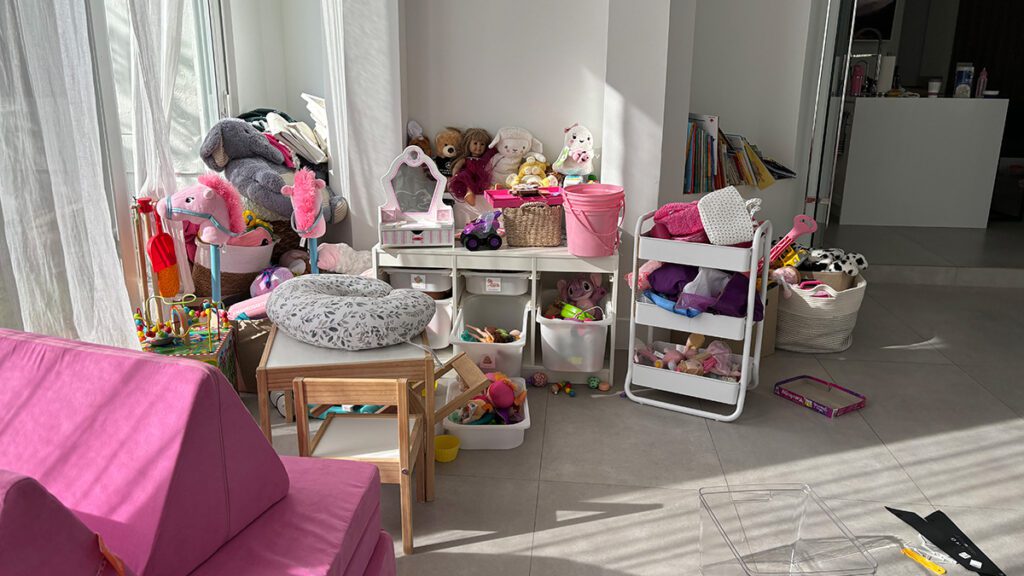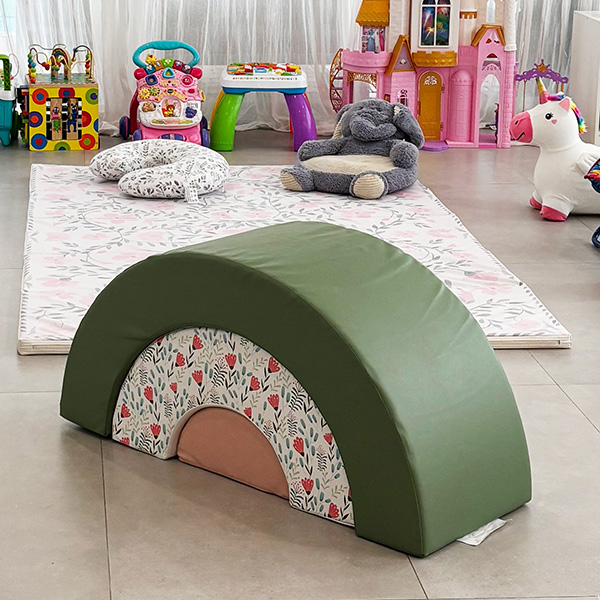Transforming a Playroom for Three Sisters: Our Hands-On Organizing Process
As a professional organizer, I find it uniquely rewarding to help families transform their spaces. Recently, I had the opportunity to work with a family of three young girls ages 1, 2.5, and 4.. The goal? To tackle the challenge of their dysfunctional playroom and make the space more organized, safer, functional, and adaptable as the girls grow.
Here’s a breakdown of our hands-on, real-time process—from start to finish. This demonstrates how we sized up the challenge and involved the family every step of the way.
Step 1: Initial Assessment and Discussion with the Family

The process began with an in-depth conversation with the parents. We needed to understand their goals and priorities for the playroom. The challenges they described were:
- Ensuring safety for the youngest one who is going through a phase where “everything goes in the mouth”.
- Creating different developmental stages without overcrowding the space.
- Creating a flexible maintenance system that would grow with their daughters.
From these insights, we developed a clear plan to balance safety, independence, and adaptability for the future.
Step 2: Organizing and Zoning the Playroom for Age-Appropriate Play
To create a functional and safe space, we began by creating separate zones in the room for the three sisters. We combined smart storage solutions with clearly defined zones based on their developmental stages. This will ensure that the room will adapt to their current needs while remaining flexible as they grow.
Safety-First Zones:

Soft Play Zone
Foam mats and soft toys created a safe, crawling-friendly area for the youngest.

Pretend Play Corner
A kitchen set and dress-up station for the older girls, with child-safe mirrors to encourage creativity.

Reading Nook
Cozy cushions and low bookshelves with board books for the youngest and picture books for the older girls.
- Art Area: Shelves at different heights with age-appropriate supplies, from crayons to scissors and glue.
- Music & Movement Space: Instruments and scarves in an open area for dancing and rhythm play.
Step 3: Implementing Practical Storage Solutions
With a clear plan in place, we worked alongside the parents to set up storage solutions that would keep the space organized and easy to maintain long-term. This step was all about turning ideas into functional, family-friendly systems:

Child-Friendly Shelving
We installed low, sturdy shelves anchored to the wall, ensuring the girls could safely and easily access their favorite toys while encouraging independence.

Safe Storage for Special Items
Closed cabinets became the perfect home for small or potentially hazardous items, such as tiny accessories or craft supplies, keeping them safely out of reach but easy for the parents to access when needed.

Organized Bins and Bags
Clear bins with simple labels made it easy for the girls to know where everything belongs. For smaller items, such as doll shoes or puzzle pieces, we used mesh bags to keep things neat and prevent anything from getting lost.
- Rotating Displays for Variety: Rotating toy shelves were introduced to reduce clutter and keep the space exciting. By showcasing only a few toys at a time, the system kept things fresh without overwhelming the kids with too many choices.
- Durable and Low-Maintenance Solutions: Washable, durable bins were chosen to handle the demands of a busy household, making cleanup quick and hassle-free.
In the final step, all we had to do was add the finishing touches. We invited the parents to walk through the space with us to ensure everything felt just right. They were thrilled with how the different zones provided clear structure for the girls, and they loved how the storage solutions balanced practicality with a touch of personalization. Seeing the excitement on their faces as the space came together made all the effort worthwhile.
Conclusion: A Playroom That Grows with the Girls
 This playroom transformation created a space where each child can safely explore her interests. The oldest practices “reading” to her siblings, the middle one enjoys pretend play, and the baby safely discovers her environment. A special “sister sharing station” became a family favorite for bonding.
This playroom transformation created a space where each child can safely explore her interests. The oldest practices “reading” to her siblings, the middle one enjoys pretend play, and the baby safely discovers her environment. A special “sister sharing station” became a family favorite for bonding.
To ensure the playroom stays organized and functional over time, we created a simple monthly maintenance plan. This includes rotating the toys, donating those the girls have outgrown, and refreshing any areas that need a quick update. The parents also implemented an easy daily cleanup routine with the girls, making it a fun, engaging part of their day. This consistent upkeep ensures the space remains enjoyable and adaptable as the girls continue to grow.
Key Takeaways:
- Color-coded storage makes cleanup easy.
- Low shelves promote independence.
- Regular toy rotation keeps interest high.
- Duplicating basic items prevents conflicts.
Pro Tips:
- Store small items in mesh bags.
- Use picture labels for easy organization.
- Keep art supplies out of reach.
- Make cleanup fun with a song routine.
Ready to create a playroom that works for your family? Get in touch to start your own transformation today!
[Note: This success story is shared with the family’s permission, with details modified to protect privacy.]

